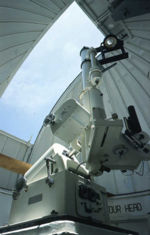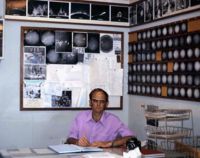Solar Telescopes
| Revision as of 02:59, 18 December 2006 (edit) Paul (Talk | contribs) ← Previous diff |
Revision as of 03:02, 18 December 2006 (edit) Paul (Talk | contribs) Next diff → |
||
| Line 3: | Line 3: | ||
| Carnarvon’s three solar telescopes were programmed to follow the Sun making daily observations. | Carnarvon’s three solar telescopes were programmed to follow the Sun making daily observations. | ||
| + | [[Image:Razdow.jpg|left|thumbnail|150px|Razdow telescope. Photo: Jim Gregg]] | ||
| The '''15cm Razdow optical telescope''' (with a narrow ½-angstrom band-pass ‘Hydrogen Alpha’ filter) set up in the SPAN roof dome. It recorded photos at 30-second intervals and produced 54m of film each day. This was refrigerated and shipped to NASA for professional processing; however, if the camera was serviced or new film arrived with a different batch number, a 2m-length was processed locally, densitometer readings were made, and the camera settings were standardised as necessary. | The '''15cm Razdow optical telescope''' (with a narrow ½-angstrom band-pass ‘Hydrogen Alpha’ filter) set up in the SPAN roof dome. It recorded photos at 30-second intervals and produced 54m of film each day. This was refrigerated and shipped to NASA for professional processing; however, if the camera was serviced or new film arrived with a different batch number, a 2m-length was processed locally, densitometer readings were made, and the camera settings were standardised as necessary. | ||
| - | [[Image:Razdow.jpg|left|thumbnail|150px|Razdow telescope. Photo: Jim Gregg]] | ||
| In a spherical radome a little to the north of the Span building sat the 2.55m parabolic-dish '''radio-telescope''' receiving radio emission at 1.420, 2.695 and 4.995 GHz, These were recorded on magnetic tape and a chart recorder. Solar-flare-induced particle showers could then be correlated with the previous several days of surface activity. | In a spherical radome a little to the north of the Span building sat the 2.55m parabolic-dish '''radio-telescope''' receiving radio emission at 1.420, 2.695 and 4.995 GHz, These were recorded on magnetic tape and a chart recorder. Solar-flare-induced particle showers could then be correlated with the previous several days of surface activity. | ||
| [[Image:Observer.jpg|right|thumbnail|200px|David Johns, Span Observer at work]] | [[Image:Observer.jpg|right|thumbnail|200px|David Johns, Span Observer at work]] | ||
| - | |||
| Finally, an unfiltered standard '''20cm scientific reflector telescope''' was set up - either on the SPAN roof or on the ground below - to project white light sun-spot images onto a clipboard ‘screen’ to allow the SPAN observers to trace sunspots. Three water-pipe ‘shoes’ were cemented into the ground to ensure the telescope was instantly aligned N-S. Sometime later, the reflector telescope was supplanted by a '''tracking white-light Solar Heliostat mirror''' to pipe the Sun’s image down inside the building. | Finally, an unfiltered standard '''20cm scientific reflector telescope''' was set up - either on the SPAN roof or on the ground below - to project white light sun-spot images onto a clipboard ‘screen’ to allow the SPAN observers to trace sunspots. Three water-pipe ‘shoes’ were cemented into the ground to ensure the telescope was instantly aligned N-S. Sometime later, the reflector telescope was supplanted by a '''tracking white-light Solar Heliostat mirror''' to pipe the Sun’s image down inside the building. | ||
Revision as of 03:02, 18 December 2006
- The Sun
- The telescopes
- Riometer
- Jupiter Monitor
- Location Project
Back to Station Equipment
Carnarvon’s three solar telescopes were programmed to follow the Sun making daily observations.
The 15cm Razdow optical telescope (with a narrow ½-angstrom band-pass ‘Hydrogen Alpha’ filter) set up in the SPAN roof dome. It recorded photos at 30-second intervals and produced 54m of film each day. This was refrigerated and shipped to NASA for professional processing; however, if the camera was serviced or new film arrived with a different batch number, a 2m-length was processed locally, densitometer readings were made, and the camera settings were standardised as necessary.
In a spherical radome a little to the north of the Span building sat the 2.55m parabolic-dish radio-telescope receiving radio emission at 1.420, 2.695 and 4.995 GHz, These were recorded on magnetic tape and a chart recorder. Solar-flare-induced particle showers could then be correlated with the previous several days of surface activity.
Finally, an unfiltered standard 20cm scientific reflector telescope was set up - either on the SPAN roof or on the ground below - to project white light sun-spot images onto a clipboard ‘screen’ to allow the SPAN observers to trace sunspots. Three water-pipe ‘shoes’ were cemented into the ground to ensure the telescope was instantly aligned N-S. Sometime later, the reflector telescope was supplanted by a tracking white-light Solar Heliostat mirror to pipe the Sun’s image down inside the building.
Two Australian scientific observers from the Ionospheric Prediction Service, Department of the Interior, (supported by AWA technical staff) interpreted the solar observations at CRO and made twice-daily reports to Mission Control, Houston; SPAN Control, Boulder; and to other interested bodies.
Later in the life of the station a newfangled facsimile machine was supplied to transmit observer sketches of sunspot activity to SPAN Control. The transmission were just adequate but after subtle adjustments to the electronic circuits, Carnarvon achieved a startling improvement. These adjustments were implemented by the rest of the SPAN network. (NAA: PP 538/1, C622, CPR, July/Sept1973)


